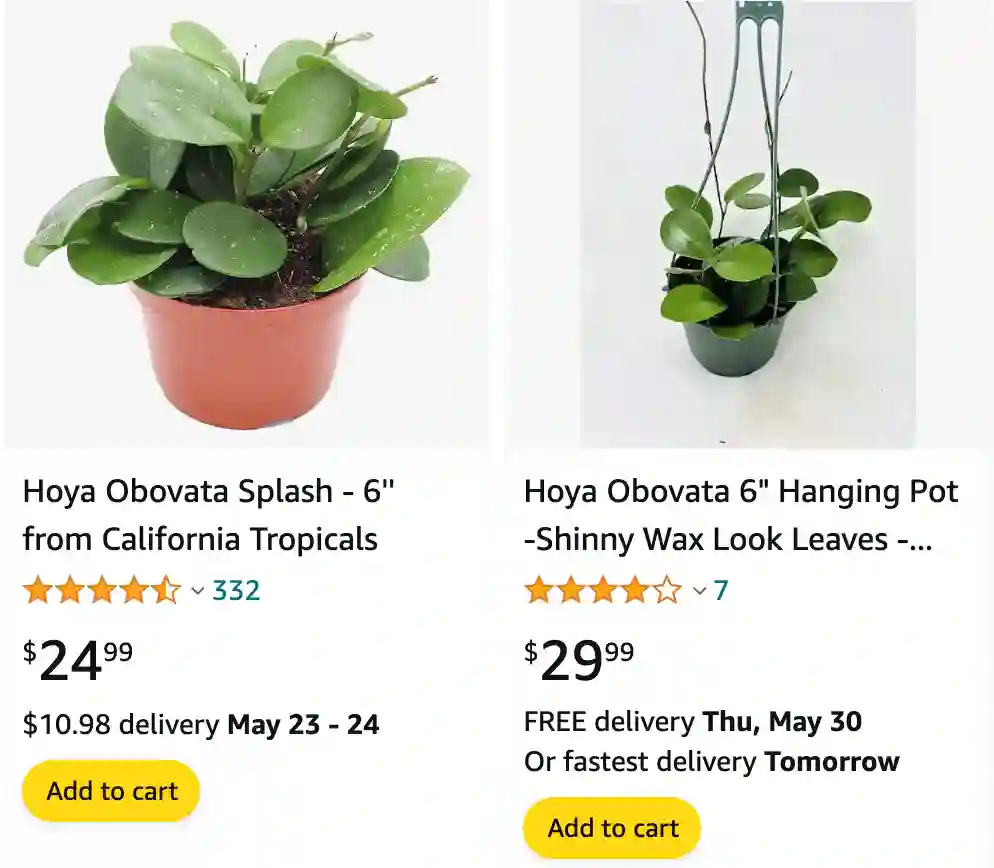
How fast does Hoya obovata grow?
Hoya obovata is considered a moderate grower among Hoyas. Its growth rate can vary depending on factors such as light, temperature, and humidity. With proper care, it typically produces new growth and extends its vines steadily throughout the growing season.
How to care for Hoya obovata?
Here’s a guide to keep your Hoya obovata thriving:
Light:
- Prefers bright, indirect sunlight. This will encourage healthy growth and potentially lead to blooms.
- Avoid harsh direct sun, especially during the hottest parts of the day, as it can scorch the leaves. Lower light can be tolerated, but the plant may grow leggy and produce fewer flowers.
Watering:
- Water deeply when the soil dries out completely. Hoya obovata prefers to dry out between waterings. Overwatering is a major threat, so it’s better to underwater than overwater.
- Sticking your finger into the soil to check moisture is a good practice. If the top inch or two feels dry, it’s time to water.
Humidity:
- Tolerates average household humidity levels. While it won’t suffer in typical conditions, it can benefit from increased humidity.
- You can increase humidity by:
- Misting the plant occasionally with lukewarm water (avoiding the flowers)
- Using a pebble tray filled with water (ensure the pot sits above the water level)
- Grouping your Hoya obovata with other plants
Temperature:
- Warm temperatures between 60-80 degrees Fahrenheit (15-27 degrees Celsius) are ideal. Protect your plant from cold drafts and sudden temperature fluctuations.
Soil and Potting:
- A well-draining potting mix is essential. A succulent or cactus mix works well, or you can use a standard potting mix with added perlite or orchid bark for extra drainage.
- Ensure your pot has drainage holes to prevent waterlogging.
Fertilizing:
- Fertilize sparingly during the growing season (spring and summer) only. Apply a balanced liquid fertilizer diluted to half strength once a month or a slow-release fertilizer formulated for houseplants according to package instructions.
- Avoid overfertilizing, as it can damage the roots.
Support (Optional):
- Hoya obovata is a natural climber. As it matures, providing a moss pole or trellis can encourage climbing growth. You can gently train the vines to climb the support structure.
Additional Tips:
- Wipe the leaves occasionally with a damp cloth to remove dust and improve light absorption. Avoid harsh chemicals or cleaning products.
- Hoya obovata is a relatively slow grower. Don’t be discouraged if it doesn’t put out new leaves frequently. Patience is key!
- Watch out for common houseplant pests like mealybugs and spider mites. Neem oil solution or insecticidal soap can be used for control.
How to propagate Hoya obovata?
Hoya obovata can be propagated through stem cuttings:
- Select a Stem Cutting: Choose a healthy stem with several leaves.
- Cutting: Use clean, sharp scissors or a knife to take a cutting below a node. Cut at a 45-degree angle.
- Rooting: Place the cutting in water or a well-draining potting mix. Roots will develop within a few weeks.
- Planting: Once roots are established, transplant into a pot with well-draining soil.
When to water Hoya obovata?
Water Hoya obovata when the top inch or two of soil feels dry to the touch. It’s essential to allow the soil to dry out slightly between waterings to prevent overwatering, which can lead to root rot.
Is Hoya obovata poisonous to cats?
Hoya obovata is not considered toxic to cats. However, it’s always a good idea to monitor pets around plants and consult a veterinarian if you suspect ingestion.
Is Hoya obovata rare?
Hoya obovata is not as common as some other Hoyas but is not considered rare in the same way as certain collector’s varieties. It can be found at nurseries specializing in tropical plants or through online sellers.
Should Hoya obovata be in terracotta?
While Hoya obovata can thrive in terracotta pots due to their porous nature, it can also do well in other types of containers as long as they provide adequate drainage. The choice of pot material depends on personal preference and the specific conditions of your growing environment.
Hoya Obovata vs Splash
Hoya Obovata Splash represents an enhanced and more visually striking iteration of the classic Hoya Obovata. While the original Hoya Obovata is recognized for its leaves adorned with silver flecks, the ‘Splash’ variety takes this feature to the next level. It showcases extensive patches of silver, which can at times encompass a significant portion of the leaf surface, making it a captivating and distinct variation.
Hoya Obovata vs Australia
When I compare my Hoya Obovata to my Hoya Australia, I notice that Obovata’s round, thick leaves have a distinct charm that stands out more in my collection. The foliage is lush and fleshy, which I find incredibly satisfying to touch. On the other hand, Hoya Australia, with its more elongated leaves, has a subtler beauty that adds a delicate touch to my indoor garden. Although both are easy to care for, I often catch myself admiring the unique patterns on the Obovata leaves a bit more frequently.
Hoya Obovata vs Kerrii
Comparing my Hoya Obovata to Hoya Kerrii is like comparing two different types of love. The Obovata’s rounded leaves give it a robust and hearty look, almost like it’s hugging the space around it. In contrast, Hoya Kerrii, with its adorable heart-shaped leaves, brings a playful and romantic vibe to my home. While the Obovata feels solid and dependable, Kerrii adds a whimsical touch, especially around Valentine’s Day when its leaf shapes seem to tell a story of love and affection.




